
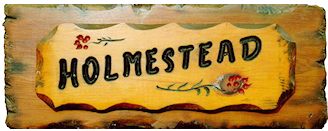
What is a wetland?
This is a brief description of wetland characteristics.
Much of our original source material was found in
Ontario Ministry of Natural Resources publications.
|
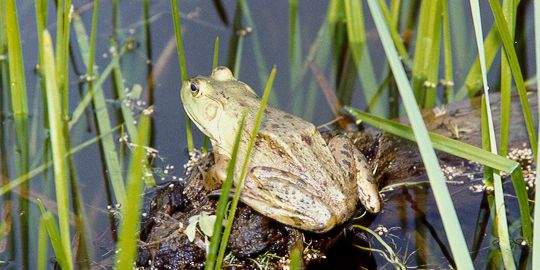
One of our "Holmestead" wetland bull frogs basking in the sun.
What are Wetlands?
Wetlands are lands that are saturated with water long enough to cause the formation of waterlogged soils and the growth of water-loving or water tolerant plants. They occur where the water table is close to or at the surface, often at low-lying inland locations, or along the margins of lakes and rivers. Some wetlands can be walked through without getting your feet wet. Others are permanently flooded. Ontario recognizes four types of wetlands: bog, fen, swamp and marsh.
What has happened to Wetlands?
Less than one-quarter of Ontario's original 2 million hectares of wetlands south of the Canadian Shield remain. Many wetlands have been drained for agriculture, development and peat extraction, others have been dredged to create harbours, boat channels, and ponds, or filled for urban and cottage development. Many of the remaining wetlands are threatened.
What are some Wetland benefits?
Wetlands provide a variety of economic, social and ecological benefits, including:
- ground water recharge and discharge
- flood damage reduction
- shoreline erosion protection
- water quality improvement
- habitat for a wide variety of plants and animals
- recreational and tourism opportunities
- valuable resource products such as wood, fish, wildlife, and wild rice which can be harvested sustainably.
Some wetland benefits are important locally or regionally. Others are continental in importance. For example, many wetlands provide essential habitat for waterfowl, shorebirds and songbirds during their annual north-south migrations.
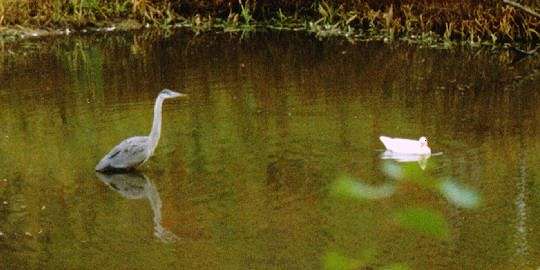
A Great Blue Heron hunting as one of our Muscovy ducks shares the wetland.
Bog Characteristics:
- peat-filled depressions that receive little surface runoff or ground water from the surrounding soils
- since rainfall is the main source of water, surface waters are acidic and low in mineral nutrients
- usually covered with a carpet of Sphagnum mosses, some sedges and shrubs (Heath Family)
- also found are unusual insect-eating plants such as sundew, pitcher plant and bladderwort
- bogs are rare in southern Ontario
Fen Characteristics:
- peatlands located in areas where ground water discharges to the surface
- vegetation usually consists of sedges, some mosses, grasses, reeds and shrubs
- unusual insect-eating plants such as sundew, pitcher plant and bladderwort are found in nutrient-poor fens
- fens are not common in southern Ontario
Swamp Characteristics:
- wooded wetlands which are flooded either seasonally or for long periods of time
- often flooded in spring, but may be quite dry in summer
- swamps include dense stands of trees, such as silver maple, black ash, white cedar and tamarack, or tall shrubs such as willow, alder and dogwood
Marsh Characteristics:
- periodically or permanently covered with water
- dominated by emergent plants such as cattails, rushes, grasses and low shrubs, with floating-leaved plants such as water lilies or by submerged plants such as coontail
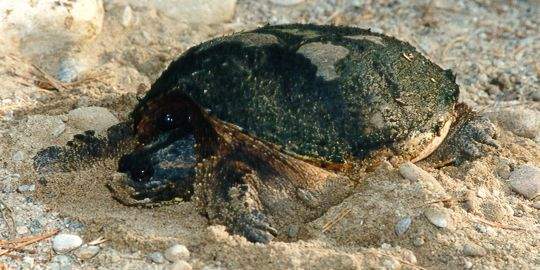
A snapper has left the wetland to lay her eggs at the side of our driveway.
The "Holmestead" - Thunder Bay Wetland:
The above describes the three main types of wetland. The Thunder Bay Wetland, of which the "Holmestead" wetland is but a small part, contains both the swamp and marsh types.
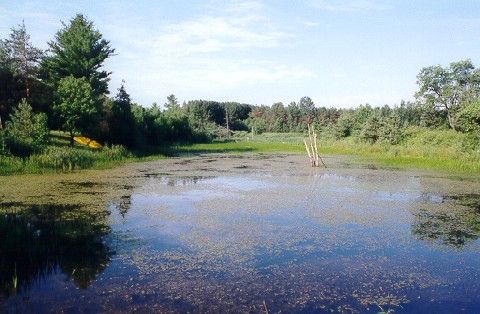
A section of the "Holmestead" wetland.
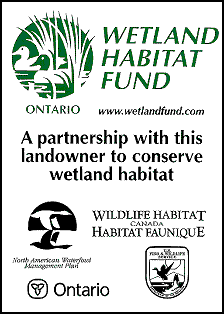 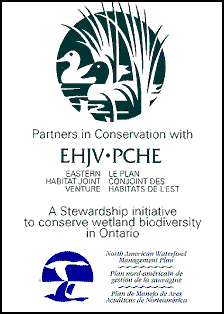
We are located to the west of the main wetland which ultimately flows into Georgian Bay. We consider ourselves as being the head waters of the wetland. Our small area is a cattail marsh where one is likely to find - in no particular order: red-winged blackbird, kingfisher, racoon, muskrat, water snake, bullfrog, plus all the other frogs of this region, dragonfly, cattail, arrowhead, coontail and all kinds of water fowl such as mallard duck, bufflehead, merganser, great blue heron, green-backed heron, American bittern, wood duck, Canada geese, wild turkeys and, especially in the Winter, many white tailed deer.
All of the above plus many other birds and animals have been seen here - usually it just a matter of watching with patience during the appropriate Season.
Perhaps you would like to see an official map of the Thunder Bay Wetland which was produced when it was first surveyed in 1987 for the purposes of provincial categorization. It contains the codes for vegetation forms and other information. Because this version of the map has been reduced from a very large sheet some details may not be too clear from our web site, but if viewed with a graphics programme it may be enlarged enough to read the smaller print:
"Wetland Map".
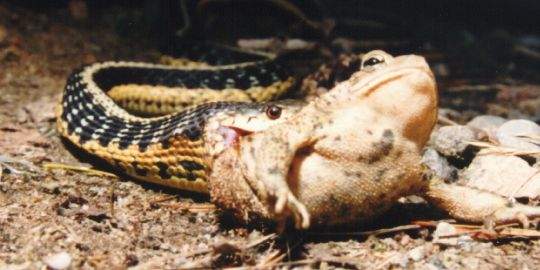
A garter snake attempting to ingest a too large toad!
In the past Ducks Unlimited Canada have given us advice on our wetland rehabilitation projects - consider visiting them.

Not exactly wildlife but Mother Muscovy and her new brood will also enjoy the wetland.
All photographs © 1997-2012 G. Brian Holmes and were taken at the "Holmestead".
|

| The "Holmestead" is located at: |
| 140 Thunder Beach Road, 17th Concession, Township of Tiny, |
| ONTARIO, L9M 0T3, CANADA |
|



